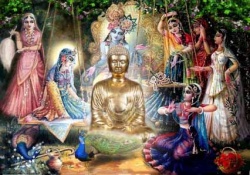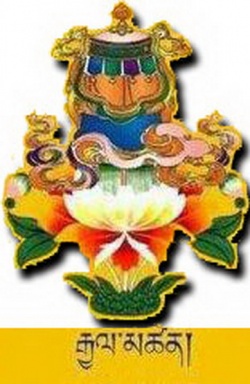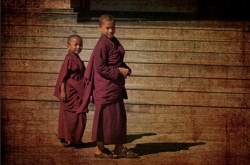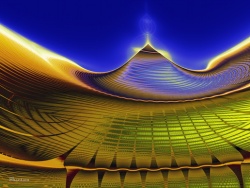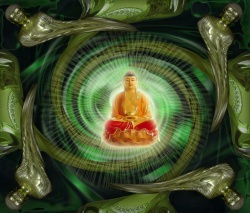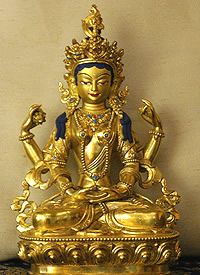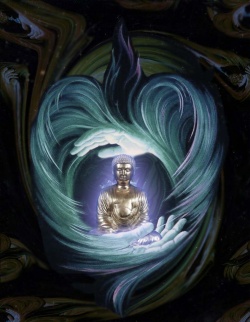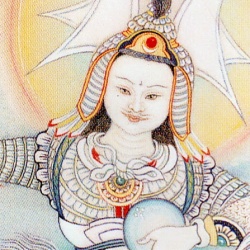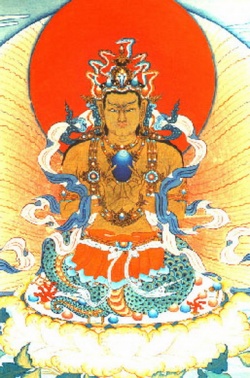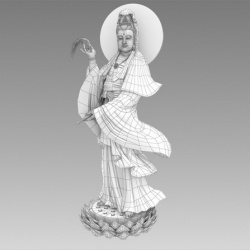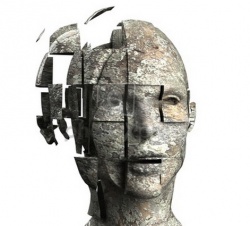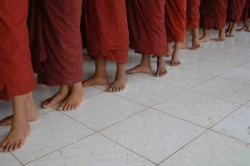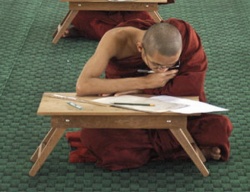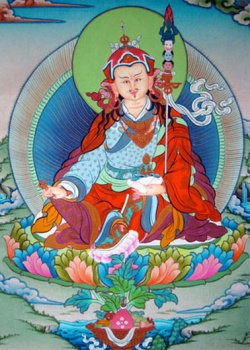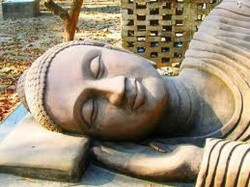The Efficiency of Anuttarayoga Tantra: Gelug
Dr. Alexander Berzin
All the details of the four points for analyzing the increased efficiency of general tantra pertain to anuttarayoga. Beyond that, however, the same four points may help us to understand why the highest class of tantra, anuttarayoga, is even speedier than the other three tantra classes are. (1) Closer Analogies
Anuttarayoga practice not only entails analogies upward with the results we are trying to achieve, as is the case in general tantra. The practices that simulate the results are also analogous downward with the bases we want to purify (sbyang-gzhi), namely our samsaric existence. Downward Analogies
Samsaric existence entails the uncontrollably recurring experience of death, bardo (the in-between state), and rebirth. We can describe the process by which the three happen as changes of subtlety of mental activity:
As we die, our consciousness becomes progressively more subtle, passing from its gross to its subtlest level in eight steps. This is because the physical bases for the grosser levels fail (thim, dissolve), in the sense that they can no longer function as supports for mental activity. At death, only clear-light laser-beam mental activity is left.
In bardo, mental activity becomes slightly grosser as we experience it giving rise to the subtle appearances that occur during the state between births.
With rebirth, mental activity becomes gross once more, back to its ordinary levels, with sense consciousness and its production of gross appearances.
The Gelug tradition focuses on purifying our future deaths, the ensuing bardos, and our next rebirths. For Gelug, purifying, here, means to eliminate our samsaric existence such that it never recurs – in other words, to achieve a true stopping (true cessation) of it.
A similar process of change in subtlety occurs when we fall asleep:
With deep sleep, we reach an extremely subtle level of mental activity.
When dreaming, the level of mental activity is slightly grosser, producing subtle appearances.
When we awaken, our mental activity returns to the gross sensory level.
Upward Analogies
Although we attain the three inseparable enlightening corpuses of a Buddha (sku-gsum, three Buddha-bodies) simultaneously with the achievement of enlightenment, we may conceive of the process as involving three steps that parallel what happens with death or sleep. The three steps are mental activity becoming the subtlest, then slightly grosser, and then more gross:
The subtlest level – Dharmakaya (chos-sku, the corpus of a Buddha that encompasses everything), referring to a Buddha’s omniscient mental activity and the nature of that activity
Slightly grosser – Dharmakaya’s giving rise to the appearances of a Sambhogakaya (longs-sku, a corpus of full use): a network of subtle forms that make full use of the bodhisattva teachings and which only arya bodhisattvas can perceive. Arya bodhisattvas are bodhisattvas who have experienced non-conceptual cognition of voidness.
Even grosser – Dharmakaya’s giving rise to the appearances of a Nirmanakaya (sprul-sku, a corpus of emanations): a network of grosser forms, emanated from Sambhogakaya, which some ordinary persons can see as well.
Alternatively, and especially in general anuttarayoga tantra, Sambhogakaya is the network of enlightening speech of a Buddha and Nirmanakaya is the network of all manifest forms of a Buddha’s enlightening body, regardless of level of subtlety. A Buddha’s speech and physical bodies are each progressively grosser than a Buddha’s enlightening mind. Taken together, Nirmanakaya and Sambhogakaya constitute a Rupakaya, a corpus of enlightening forms (gzugs-sku, form body).
The Analogous Practices
The anuttarayoga practices for achieving the mind and form bodies of a Buddha are analogous to the three-step process of both the basis and the resultant levels.
When we die or fall asleep on the basis level, or when we achieve a Dharmakaya on the resultant level, we get down to the subtlest level of mental activity, in eight steps. Similarly, on the anuttarayoga path, to gain non-conceptual cognition of voidness as the cause for a Buddha’s enlightening mind, we also go down, in eight steps, to the subtlest level of mind, and access and harness it for this cognition.
First, we do this in our imaginations on the generation stage. When our attainments of all the necessary meditation tools are complete through extensive practice in our imaginations, we reach our clear-light minds in actuality as we advance through the steps of the complete stage.
Note that clear-light mind, as a term for clear-light mental activity, does not mean that all beings share one clear-light mind. Just as the voidness of each phenomenon is an individual voidness, likewise clear-light mind, as a level of mental activity, is individual in each being.
2. When we achieve a bardo or dream state on a basis level, or a Sambhogakaya on the resultant level, our mental activity becomes slightly grosser. Likewise, within the state of understanding voidness, we arise on the path in a subtle form, such as a creative energy-drop (thig-le, Skt. bindu), a seed-syllable (sa-bon), or a simplified Buddha-figure.
3. When we take rebirth or wake up on a basis level, or manifest a Nirmanakaya on a resultant one, our mental activity produces gross appearances that normal eye consciousness can perceive. Similarly, on the path, we make the subtle form of a creative energy-drop, and so on, appear in a grosser aspect as the full body of a Buddha-figure.
We may understand the purification process by an analogy. Suppose there are two two-story houses sharing one basement in which is located the common source of electricity for both houses. One house is the basis situation of samsara; the other is the resultant situation of enlightenment. The ground story of each house is the level of subtle appearances; the top story is the level of grosser appearances. The common basement is the level of clear-light mental activity.
Suppose that the electricity is flowing only to the samsara house, not to the enlightenment house. To disconnect the electricity from the samsara house and connect it to the enlightenment house, we need to go down an eight-step staircase to the basement and change the connection. Likewise, to purify samsara, in the sense of causing it never to recur, we need to go down to the clear-light level in eight steps and disconnect the appearance-making mechanism from giving rise to the appearances of samsara. We do this with non-conceptual cognition of voidness. In doing so, we automatically connect the appearance-making mechanism to the enlightenment house so that it produces the subtle and gross appearances of the physical corpuses of a Buddha.
Before we are able actually to reach the basement and reconnect the wires, we need to practice the entire procedure, in the sense of rehearsing it. In other words, we practice doing something that resembles the procedure – first in our imaginations and then in actual simulations. This is what it means to practice a path that is analogous to both the basis we wish to purify and the result we wish to attain. Rehearsing in our imaginations corresponds to generation stage practice; rehearsing with actual simulations corresponds to complete stage practice.
Thus, in anuttarayoga, there are not only more analogies than general tantra contains, both upward with the result and downward with the basis, but also closer analogies. Moreover, the practice mimics not only the phenomena we experience on both resultant and basis levels, but also with how we gain their experience in both. These practices are therefore called "taking pathway minds for (attaining) the three corpuses of a Buddha" (sku-gsum lam-'khyer):
Taking death as a pathway mind for (attaining) a Dharmakaya ('chi-ba chos-sku lam-'khyer)
Taking bardo as a pathway mind for (attaining) a Sambhogakaya (bar-do longs-sku lam-'khyer)
Taking birth as a pathway mind for (attaining) a Nirmanakaya (skye-ba sprul-sku lam-'khyer).
(2) Closer Union of Method and Wisdom
Method in Terms of the Appearance of a Body
Just as there are three levels of mental activity, there are also three levels of body that support them:
The gross level – the body of flesh and blood, with its sensory apparatus
The subtle level – the body of the subtle energy-system of chakras (energy-nodes), channels, energy-winds, and creative energy-drops
The subtlest level body – the subtlest energy-wind, which is the physical support or counterpart of the subtlest level of mental activity.
General tantra unites method and wisdom as two truths about the same phenomenon by taking them as a mind’s:
Actively producing, or at least having as its physical basis, the appearance of a Buddha-figure’s body;
Cognizing the voidness of that appearance.
According to the Gelug explanation, the phenomenon here in general tantra is the subtle level of mental activity – our usual mental cognition or yogic non-conceptual cognition. Two inseparable truths about this phenomenon are its cognitive aspect and its supporting subtle energy-wind. The appearance of a Buddha-figure that our usual mental cognition or yogic cognition produces is made from this subtle energy-wind. However, our subtle levels of mental activity and body do not continue into enlightenment. They do not even continue during our death existence, before they reemerge with bardo.
In anuttarayoga, on the other hand, we access two aspects of the subtlest level of our mental activity – its clear light cognition and its subtlest energy-wind. Both continue into Buddhahood. Their continuums never cease, even during the period of death. In fact, the inseparable pair underlies every moment of our experience. As wisdom, we generate clear-light mental activity into non-conceptual cognition of voidness and, as method, we generate its supporting subtlest energy-wind into an appearance of a Buddha-figure. This appearance is called a “purified illusory body” (dag-pa’i sgyu-lus). It is purified of the emotional obscurations (nyon-sgrib) preventing liberation. Non-conceptual clear-light cognition of voidness is called “actual clear light” (don-gyi ‘od-gsal).
Thus, the union of method and wisdom with the clear-light level in anuttarayoga is closer than that in general tantra because method and wisdom in anuttarayoga are not only inseparable. They are accessible each moment, as are the enlightening body and mind of a Buddha.
Moreover, all appearances made of subtle energy-wind appear to exist with true existence, which is not how they actually exist at all. Thus, with the subtle level of mental activity, cognition of the appearance of a Buddha-figure cannot occur simultaneously with either conceptual or non-conceptual cognition of voidness. As a union of method and wisdom, they can only alternate with equivalent cognitive manners of taking their objects.
In contrast, appearances made solely from subtlest energy-wind appear to exist in the manner in which they actually exist. They appear to exist as dependently-arising phenomena (rten-‘brel, Skt. pratityasamutpada) – namely, as phenomena that arise as “this”s or “that”s dependently solely on what the mental labels for them refer to when imputed on a valid basis for labeling. Thus, because dependently-arising phenomena appear as absolutely devoid of existing with true existence, they can appear simultaneously with clear-light non-conceptual cognition of voidness.
Non-conceptual focus on an absence of true existence occludes (khegs, blocks) an appearance of true existence, because an absence and a presence of true existence are mutually exclusive. Such focus does not occlude, however, an appearance of a manner of existence that is absolutely devoid of true existence – namely, an appearance of dependently-arising existence. This is because an absence of true existence and a presence of dependently-arising existence are synonymous.
Thus, the union of method and wisdom in anuttarayoga is especially close because the equivalent manners of cognitively taking the inseparable pair – purified illusory body and actual clear light – can occur simultaneously.
Method in Terms of a Blissful Awareness
In anuttarayoga tantra, method refers not only to producing the body of a Buddha from the subtlest energy-winds, but also to using a blissful awareness for the cognition of voidness. Occasionally, we differentiate the four classes of tantra according to progressively more intense levels of bliss (bde-ba) that each of the tantra classes suggests:
Kriya tantra – the bliss from seeing a partner
Charya – from exchanging smiles
Yoga – from hugging or holding hands
Anuttarayoga – the bliss from sexual union with a partner.
The three lower classes of tantra, however, do not necessarily make explicit use of a blissful awareness as method. The four levels of bliss are analogies, made in terms of a feature found specifically in anuttarayoga, to indicate progressively more intense levels of mind in the four tantra classes.
Furthermore, the bliss of sexual union that anuttarayoga practice uses as a method is not the bliss of orgasm (‘dzag-bde) that arises in ordinary sexual union. Tantra practice never entails orgasmic release or degenerate orgies. To think that it does is a complete misunderstanding of tantra. The point of generating a blissful awareness through the contact of the subtle energy-channels of the two sexual organs is that it naturally leads toward the subtlest level of mind. We wish to access, sustain, and use this clear-light level of mental activity for the cognition of voidness.
When we sneeze, yawn, faint, fall into deep sleep, die, or experience the most intense bliss of sexual union, the subtle energy-winds naturally draw inward and our mental activity approaches the subtlest level. With sneezing or yawning, it is extremely difficult to sustain in meditation the natural dissolution of the energy-winds so that we can focus for an extended period on voidness without the winds immediately exploding back out. Harnessing the fainting, sleeping, or dying state is likewise difficult, because the mind tends to be dull on those occasions. If, however, through advanced internal yoga methods, we gain control over our subtle energy-winds so that we can prevent their explosive release with orgasm, we can sustain the blissful awareness of union and its naturally resulting subtler level of mind. We can then use it to dissolve the energy-winds even further to the clear-light level and then to apply that blissful clear-light awareness to sustained cognition of voidness.
The Two Sets of Obscuration
Two sets of fleeting stains obscure clear-light mental activity:
The emotional obscurations (obstacles) (nyon-sgrib) that are the disturbing emotions and attitudes and which prevent liberation
The cognitive obscurations (shes-sgrib) regarding all knowables and which prevent the omniscience of enlightenment.
The cognitive obscurations include the constant habits (bag-chags, instincts) of grasping for true existence, which, Gelug-Prasangika uniquely asserts, produce appearances of true existence every moment of our conceptual and usual non-conceptual cognition. Because of producing such appearances, these constant habits prevent us from cognizing the two truths about anything simultaneously – its appearance and its voidness.
According to Gelug-Prasangika, the emotional obscurations include grasping for true existence (bden-‘dzin), with which we believe that the appearances of true existence that we cognize correspond to reality. It also includes the disturbing emotions and attitudes – both doctrinally based (kun-brtags) and automatically arising (lhan-skyes) – which all derive from this grasping. Likewise, this set of obscurations also includes the legacies (sa-bon, seed, tendency) of both types of disturbing emotions and attitudes, which give rise to them intermittently.
Doctrinally based disturbing emotions and attitudes derive from having studied and accepted distorted views of reality as taught by non-Prasangika tenet systems. Such disturbing emotions and attitudes arise only during conceptual cognition. Examples are the stubborn attachment and defensiveness that arise when someone challenges our incorrect beliefs.
Automatically-arising disturbing emotions and attitudes arise even in non-conceptual sense cognition, such as the anger and attachment that arise in humans and animals when seeing someone grab their favorite toy away from them.
Non-conceptual cognition of voidness is the true pathway of mind that achieves a true stopping (true cessation) of the two sets of obscurations, such that they never recur. First, it eliminates the emotional obscurations. Only when it has removed all of them forever does it begin to eliminate the cognitive obscurations.
Moreover, non-conceptual cognition of voidness requires the force of a determination to be free (renunciation) to eliminate the emotional obscurations preventing liberation. It further requires bodhichitta to cut through the cognitive obscurations preventing omniscience. To cut through the subtlest level of this second set of obscurations, however, the nonconceptual cognition of voidness, held with the forces of renunciation and bodhichitta, must be with the clear-light level of mental activity.
The Necessity for a Blissful Awareness of Voidness
Clear-light mental activity does not necessarily cognize voidness, although according to the explanation of the fifteenth-century Gelug master Kedrub Norzang-gyatso (mKhas-grub Nor-bzang rgya-mtsho), it naturally produces a cognitive appearance similar to that of voidness. Nor is clear-light cognition necessarily blissful, for instance in death. Nevertheless, by using the bliss of sexual union as a method for accessing our subtlest level of mental activity and then for cognizing voidness with that blissful clear-light mind, anuttarayoga practice leads to the most efficient cognitive tool for cutting through all obscurations.
The anuttarayoga cognitive tool, then, is simultaneously:
A clear-light level of mental activity
A blissful awareness
A non-conceptual cognition of voidness
A cognition held with the force of the determination to be free
A cognition held with the force of bodhichitta.
A blissful awareness, a non-conceptual cognition of voidness, and a clear-light cognition are not necessarily inseparable phenomena – one can occur in a moment of cognition without the others simultaneously occurring. Nevertheless, anuttarayoga practice makes them inseparable truths about the same phenomenon: one moment of cognition.
In other words, just as one can hit a target with different arrows, one can use a variety of minds to gain non-conceptual cognition of voidness. Anuttarayoga uses a blissful clear-light mind, gained through blissful awareness on grosser levels, as the arrow for non-conceptually perceiving voidness. In this way, blissful clear-light awareness is the mind with non-conceptual cognition of voidness, and thus the union of method and wisdom in anuttarayoga is especially close. Gelug calls this closeness “inseparable voidness and bliss.”
[For a more advanced discussion, see: Relationships between Objects in Anuttarayoga Tantra]
The graphic representation of Buddha-figure couples in union symbolizes method and wisdom as two inseparable truths about one phenomenon – clear-light cognition. Yab-yum, the Tibetan term for the couple, does not mean male and female, or masculine and feminine. It means father and mother. When the causes for the body and mind of a Buddha are made inseparable truths about clear-light mental activity, they give birth to enlightenment, as a sexually united father and mother do to a child.
In short, the subtlest energy-wind and the clear-light mental activity that it supports are already inseparable truths about clear-light mental activity. Anuttarayoga practice generates the subtlest energy-wind in the form of a Buddha-figure couple – not just in the form of one member of the couple – and the clear-light mental activity as a non-conceptual cognition of voidness. Moreover, it accesses the clear-light level through a blissful awareness, and in doing so, generates clear-light cognition as inseparably a blissful awareness. Thus, anuttarayoga takes clear-light cognition of voidness as wisdom and, as method, both makes it inseparably a blissful awareness and makes the energy-wind that already is inseparable with it appear in the form of a Buddha-figure couple.
(3) Special Basis for Voidness
In anuttarayoga tantra, the special basis for voidness is not simply the body of a Buddha-figure generated from the subtle energy-winds of our imaginations, as in general tantra. It is such a body generated from the subtlest energy-winds of our clear-light minds. Since the clear-light level of mental activity underlies each moment of our experience, the energy-wind of that level is always available for use in meditation. Thus, anuttarayoga provides an even more stable basis for voidness upon which to focus than does general tantra.
(4) Special Level of Mental Activity
Introductory Remarks
Regardless of which level of mind we use to cognize voidness, voidness itself remains the same. The absence of impossible ways of existing understood in bodhisattva sutra and all four classes of tantra is the same. Using the subtlest clear-light level of mental activity for this cognition, however, has many additional advantages besides its being always available for practice. This is because clear-light cognition of voidness does not require three zillion (countless) eons to cut through the emotional and cognitive obscurations, as does sutra practice.
According to Gelug-Prasangika, sutra practice requires:
A zillion eons to reach yogic non-conceptual cognition of voidness and thus a seeing pathway mind (path of seeing), with the elimination forever of doctrinally based disturbing emotions and attitudes and their legacies.
A second set of zillion eons to eliminate forever the rest of the emotional obscurations preventing liberation and thus to attain the eighth out of ten levels of bhumi mind of arya bodhisattvas (byang-sa). The first seven levels of bhumi mind are unpurified bhumi minds (ma-dag-pa’i sa) – in other words, levels of a highly realized bodhisattva mind not fully purified of the emotional obscurations;
A third set of zillion eons to eliminate forever the cognitive obscurations preventing omniscience and thus to complete the attainment of the last three levels of bhumi mind of arya bodhisattvas, the purified bhumi minds (dag-pa’i sa) and attain enlightenment.
Clear-Light Mental Activity Is Naturally Non-conceptual
The subtle level of mental activity, the second of the three levels of mind, may be either conceptual or non-conceptual. Staying on this level requires the first zillion eons of strengthening our enlightenment-building networks of positive force and deep awareness in order for our cognition of voidness to become non-conceptual. This is because our mental activity remains on the same level of subtlety as is conceptual cognition. Consequently, our trying to gain non-conceptual cognition of voidness with this level of mind resembles a rabbit’s trying to escape from a fox while remaining on the ground with the fox. Even if the rabbit hides, the fox can still find and catch it.
Clear-light mental activity, in contrast, is subtler than all levels of conceptual cognition and thus is exclusively non-conceptual. Therefore, gaining non-conceptual cognition of voidness with a clear-light mind is like the rabbit diving into a deep hole. Just in so doing, it escapes the fox. As soon as we access this subtlest level and focus it on voidness, our cognition of voidness is automatically non-conceptual. It automatically rids us forever of doctrinally based disturbing emotions and attitudes. The first zillion eons are not required.
Moreover, because anuttarayoga accesses clear-light cognition through generating a blissful awareness and dissolving the subtle energy-winds in the central channel, the non-conceptuality of clear-light mind is easier to maintain than the non-conceptuality of grosser levels.
Clear-Light Mental Activity Is Naturally Free of All Disturbing Emotions and Attitudes
During non-conceptual total absorption on voidness, all disturbing emotions and attitudes are absent, whether we use the subtle or the subtlest level of mind for this cognition. With the subtle mind, however, held by the force of bodhichitta, the initial non-conceptual absorption on voidness removes forever only the disturbing emotions and attitudes that are doctrinally based. Total elimination (true cessation) of the automatically-arising disturbing emotions and attitudes, such that they never arise again, requires a second zillion eons.
Disturbing emotions and attitudes may accompany only gross and subtle mental activities – our usual sensory and mental cognitions. Clear-light mental activity, on the other hand, being subtler than these two levels of mind, is naturally free of all disturbing emotions and attitudes. By the power of this natural absence, the initial clear-light absorption on voidness has the force to remove forever the doctrinally based and automatically-arising disturbing emotions and attitudes simultaneously. An additional second set of zillion eons is not required. Non-conceptual clear-light cognition of voidness and the total removal of all emotional obscurations preventing liberation occur simultaneously. Clear-Light Mental Activity Does Not Produce Appearances of True Existence
The subtle level of mental activity, whether conceptual or non-conceptual, produces appearances only of true existence. Therefore, when subtle mental activity non-conceptually cognizes voidness, it cannot simultaneously give rise to any appearance. One moment of mind cannot cognize an absolute absence of true existence and simultaneously make an appearance of true existence. The two are mutually exclusive. Thus, because subtle mental activity can only produce and cognize an unpurified appearance of something, it cannot cognize the two truths about anything simultaneously: that object’s appearance and its actual mode of existence.
Clear-light cognition, on the other hand, produces only purified appearances – appearances of a mode of existence totally devoid of all impossible ways. Thus, clear-light cognition – and only clear light cognition – can simultaneously cognize appearances and voidness. Specifically, it can simultaneously cognize appearances of a mode of existence devoid of true existence and an absolute absence of true existence. For this reason, even in sutra and the three lower classes of tantra, one needs ultimately to access and use clear-light mental activity for cognizing voidness. This is in order to cognize the two truths about things simultaneously, as a Buddha’s omniscient awareness does.
Using the sutra methods requires a third zillion eons to achieve clear-light cognition of voidness. The methods of the three lower tantras bring it more quickly, but still require a great amount of time. In either case, this clear-light cognition occurs only during the final phase of practice before Buddhahood, namely at the final phase of a tenth -level bhumi mind. Anuttarayoga accesses it already when first gaining non-conceptual cognition of voidness – in other words, with the attainment of a seeing pathway mind and a first level bhumi mind. Thus, anuttaryoga does not require the third zillion eons to gain simultaneous cognition of the superficial and deepest truths about the Buddha-figure body that it makes appear. Nevertheless, anuttarayoga still requires considerable familiarization with cognizing the two truths simultaneously, in order to maintain such cognition as a Buddha does, without any break.
Clear-Light Mental Activity Can Have Omniscient Awareness
The mode of existence with which everything actually exists, and which clear-light mental activity cognizes simultaneously with everything’s absence of existing in impossible ways, is as dependently-arising phenomena. Everything arises or exists dependently on, or in relation to:
A basis for labeling, a mental label, and what the mental label refers to
Parts
In the case of nonstatic (impermanent) phenomena, causes and conditions.
Moreover, everything arises or exists interrelatedly and interdependently. Everything that occurs at this moment
Has arisen dependently on everything that has ever occurred before, such as history and so on
Is interconnected with everything else that is occurring now
Will affect everything that will occur in the future.
Thus, in accurately cognizing the interdependence and interrelatedness of everything, clear-light mental activity becomes omniscient awareness.
When first accessed, however, clear-light mind does not function omnisciently. Although it is naturally free of the emotional obscurations that are disturbing emotions and attitudes, it is not free of the cognitive obscurations regarding all knowables. This latter set of obscurations gives rise to appearances of true existence, although not while clear-light mental activity is manifest.
So long as the appearance-making of true existence can recur, the cognitive obscurations still exist as what can be labeled or imputed on the mental continuum. When clear-light mental activity can be maintained forever, without any break, the existence of the cognitive obscurations can no longer be imputed on that mental continuum. At this point, the clear-light mental activity of that mental continuum becomes omniscient awareness. This is the attainment of only a Buddha. Because of its special practices with clear-light mental activity, anuttarayoga does not require the third zillion eons to reach this omniscient state.
